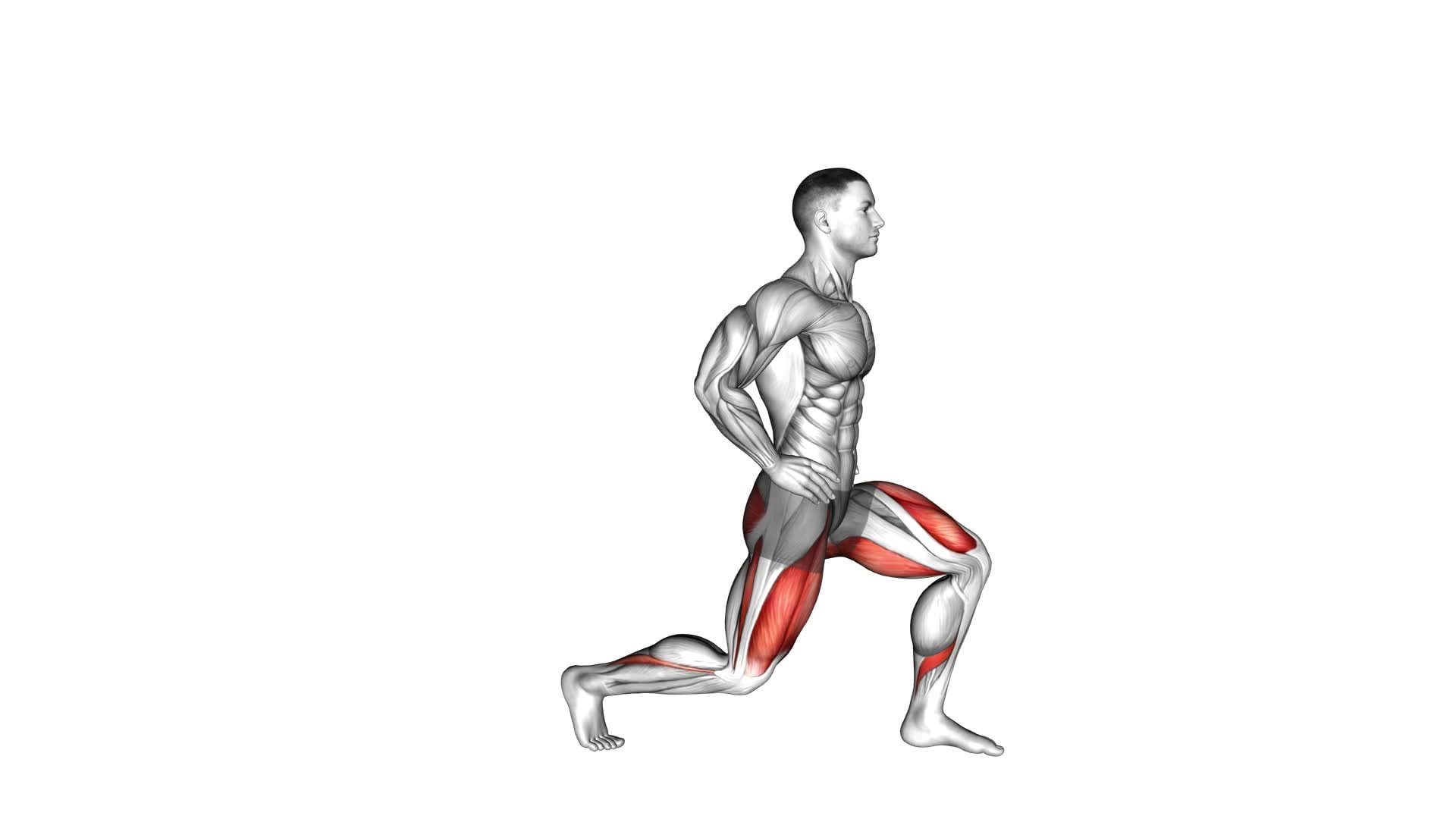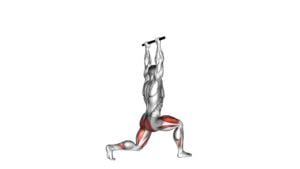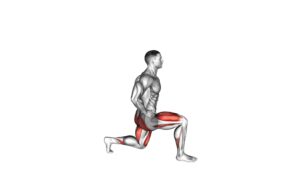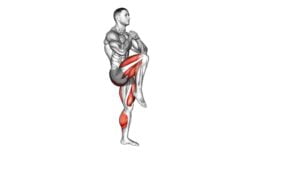Bodyweight Pulse Forward Lunge – Video Exercise Guide & Tips

Are you looking for a challenging lower body exercise that can be done anywhere? Look no further than the bodyweight pulse forward lunge.
Watch This Exercise Video
This exercise targets your quads, glutes, and hamstrings while also improving your balance and stability.
In this video exercise guide, we'll show you the proper technique, common mistakes to avoid, and tips to increase intensity.
Get ready to feel the burn and take your lunges to the next level!
Key Takeaways
- The bodyweight pulse forward lunge targets multiple muscle groups including quads, glutes, hamstrings, and calves.
- It improves lower body strength, tones legs, and enhances balance and stability.
- The exercise engages cardiovascular endurance, helping with weight loss and calorie burning.
- Proper technique and form are important to avoid common mistakes and maximize the benefits of the exercise.
Benefits of the Bodyweight Pulse Forward Lunge
You can enhance your lower body strength and improve your balance with the bodyweight pulse forward lunge. The benefits of this exercise are numerous.
Firstly, it targets multiple muscle groups including the quadriceps, hamstrings, glutes, and calves, resulting in increased strength and toned legs. Additionally, the pulsing motion engages the muscles for a longer duration, leading to improved muscular endurance.
Performing the bodyweight pulse forward lunge correctly is essential to reap all the benefits. Start by standing with your feet hip-width apart and take a big step forward with your right foot. Lower your body down until both knees are bent at a 90-degree angle, ensuring that your front knee doesn't extend past your toes.
Now, instead of returning to the starting position immediately, pulse up and down slightly, keeping tension in your muscles. Repeat this motion for the desired number of repetitions before switching sides.
To maximize the benefits, it's crucial to maintain proper form throughout the exercise. Keep your core engaged, chest lifted, and back straight. Focus on pushing through your front heel to activate your glutes and hamstrings. Remember to breathe consistently throughout the movement.
Incorporating the bodyweight pulse forward lunge into your workout routine can help you build lower body strength, improve balance, and enhance overall athletic performance.
Proper Technique for the Bodyweight Pulse Forward Lunge
To perform the bodyweight pulse forward lunge with proper technique, follow these guidelines:
- Start by standing with your feet shoulder-width apart and arms relaxed at your sides.
- Take a step forward with your right foot, ensuring that your knee is directly above your ankle and your thigh is parallel to the ground.
- While maintaining a straight back and engaging your core, lower your body by bending both knees until your left knee is hovering just above the ground.
- Hold this position for a brief moment, then push through your right heel to return to the starting position.
- Repeat the movement on the opposite side, alternating between the right and left leg.
By incorporating the bodyweight pulse forward lunge into your exercise routine, you can improve your balance and increase flexibility in your lower body. The pulsing motion engages your muscles for a longer duration, making it an effective exercise for building strength and stability.
Additionally, the forward lunge targets multiple muscle groups, including the quadriceps, hamstrings, glutes, and calves. Remember to maintain proper form throughout the exercise, keeping your chest lifted, shoulders relaxed, and focusing on a controlled movement.
As you progress, you can increase the difficulty by adding dumbbells or performing the lunges on an unstable surface.
Common Mistakes to Avoid During the Bodyweight Pulse Forward Lunge
One common mistake to avoid during the bodyweight pulse forward lunge is neglecting to maintain proper knee alignment. It's crucial to ensure that your knees are in line with your toes throughout the entire movement. Failing to do so can put unnecessary strain on your knee joints and increase the risk of injury. To maintain proper knee alignment, make sure that your front knee stays directly above your ankle and doesn't collapse inward or extend too far beyond your toes.
Additionally, avoid letting your back knee touch the ground or bending it at an extreme angle. Another common mistake isn't engaging your core muscles. Your core plays a significant role in stabilizing your body during the lunge and preventing any excessive forward or backward leaning. Remember to keep your core tight and your spine neutral throughout the exercise.
Lastly, avoid rushing through the movement. Instead, focus on maintaining control and performing each lunge with proper form. By avoiding these common mistakes and practicing proper technique, you can maximize the effectiveness of the bodyweight pulse forward lunge while minimizing the risk of injury.
Tips to Increase Intensity and Progression in the Bodyweight Pulse Forward Lunge
To increase intensity and progression in the bodyweight pulse forward lunge, incorporate additional resistance such as dumbbells or resistance bands. Here are three ways to add resistance and advanced variations to your bodyweight pulse forward lunge:
- Weighted Lunges: Hold a pair of dumbbells in your hands, resting them on your shoulders or letting them hang by your sides. This added weight increases the resistance on your muscles and intensifies the exercise.
- Resistance Band Lunges: Attach a resistance band around your thighs or ankles. As you perform the pulse forward lunge, the band provides continuous tension, challenging your muscles even more.
- Plyometric Lunges: Once you've mastered the basic pulse forward lunge, you can progress to plyometric variations. Instead of pulsing in place, explode off the ground and switch legs mid-air, landing softly into the next lunge. This explosive movement engages your muscles and cardiovascular system, taking the intensity to a whole new level.
Modifications and Variations for the Bodyweight Pulse Forward Lunge
Try incorporating different modifications and variations to challenge yourself during the bodyweight pulse forward lunge. These alternatives will help you target different muscle groups and add variety to your workout routine.
One modification you can try is the weighted pulse forward lunge. Instead of using just your bodyweight, hold a dumbbell or kettlebell in each hand to increase the resistance. This will make the exercise more challenging and help you build strength in your legs and glutes.
Another variation you can incorporate is the reverse pulse forward lunge. Instead of stepping forward with your front leg, you'll step backward. This variation puts more emphasis on your hamstrings and glutes and can help improve your balance.
In terms of equipment needed, the bodyweight pulse forward lunge requires no equipment at all. However, if you decide to try the weighted pulse forward lunge, you'll need dumbbells or kettlebells. Make sure to choose a weight that challenges you but still allows you to maintain proper form throughout the exercise.
Remember to listen to your body and start with modifications that suit your fitness level. As you become more comfortable, you can gradually increase the intensity by trying different variations. Incorporating these modifications and variations will keep your workouts exciting and help you continue making progress.
Frequently Asked Questions
How Many Calories Does the Bodyweight Pulse Forward Lunge Burn?
The bodyweight pulse forward lunge is a great exercise for burning calories. It targets multiple muscle groups, including the legs, glutes, and core. By incorporating a pulsing movement, it adds an extra challenge and increases the calorie burn.
This exercise can be modified to be knee-friendly by reducing the depth of the lunge or using a step or bench for support.
Can the Bodyweight Pulse Forward Lunge Help Improve Balance?
The bodyweight pulse forward lunge can definitely help improve your balance and stability. By engaging the muscles in your legs and core, this exercise challenges your body to maintain control and coordination.
Additionally, there are variations of the bodyweight pulse forward lunge that can further enhance your balance, such as adding a twist or incorporating weights. By consistently practicing these lunges, you can strengthen your muscles and improve your overall stability.
Is It Safe to Perform the Bodyweight Pulse Forward Lunge if I Have Knee Pain?
If you have knee pain, it may not be safe for you to perform the bodyweight pulse forward lunge. This exercise puts stress on the knees, which could exacerbate your pain.
Instead, consider modifying the exercise by reducing the depth of the lunge or using a chair for support. Alternatively, you can try other exercises that don't put as much strain on the knees, such as step-ups or glute bridges.
Always listen to your body and consult with a healthcare professional if you're unsure.
Can the Bodyweight Pulse Forward Lunge Help Build Muscle in the Lower Body?
The bodyweight pulse forward lunge is a great exercise for building muscle in your lower body. It targets your quadriceps, hamstrings, and glutes, helping to strengthen and tone those muscles.
By adding a pulsing motion, you increase the intensity and effectiveness of the exercise.
If you're looking for alternatives, squats and lunges with weights are also excellent for lower body strength training.
Remember to listen to your body and modify exercises if you have knee pain.
How Often Should I Incorporate the Bodyweight Pulse Forward Lunge Into My Workout Routine for Optimal Results?
To get optimal results, you should consider incorporating the bodyweight pulse forward lunge into your workout routine.
The frequency at which you perform this exercise depends on your fitness goals and overall workout plan. It's recommended to start with 2-3 times per week and gradually increase as your strength and endurance improve.
Additionally, to keep your routine challenging and prevent plateaus, you can also try different lunge variations such as weighted lunges or walking lunges.
Conclusion
In conclusion, the bodyweight pulse forward lunge is a highly effective exercise for targeting the lower body muscles and improving balance and stability.
By following proper technique and avoiding common mistakes, you can maximize the benefits of this exercise.
Incorporating modifications and variations can help increase intensity and progression over time.
So, give the bodyweight pulse forward lunge a try and enjoy the results it brings to your fitness routine.

Author
Years ago, the spark of my life’s passion ignited in my mind the moment I stepped into the local gym for the first time. The inaugural bead of perspiration, the initial endeavor, the very first surge of endorphins, and a sense of pride that washed over me post-workout marked the beginning of my deep-seated interest in strength sports, fitness, and sports nutrition. This very curiosity blossomed rapidly into a profound fascination, propelling me to earn a Master’s degree in Physical Education from the Academy of Physical Education in Krakow, followed by a Sports Manager diploma from the Jagiellonian University. My journey of growth led me to gain more specialized qualifications, such as being a certified personal trainer with a focus on sports dietetics, a lifeguard, and an instructor for wellness and corrective gymnastics. Theoretical knowledge paired seamlessly with practical experience, reinforcing my belief that the transformation of individuals under my guidance was also a reflection of my personal growth. This belief holds true even today. Each day, I strive to push the boundaries and explore new realms. These realms gently elevate me to greater heights. The unique combination of passion for my field and the continuous quest for growth fuels my drive to break new ground.







